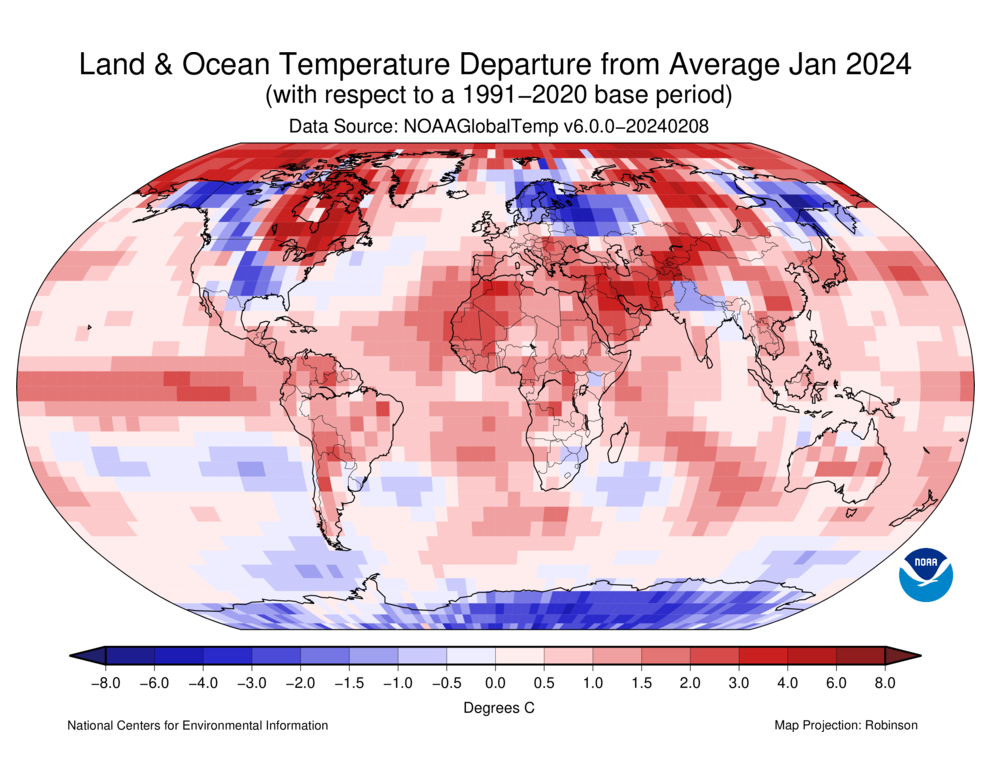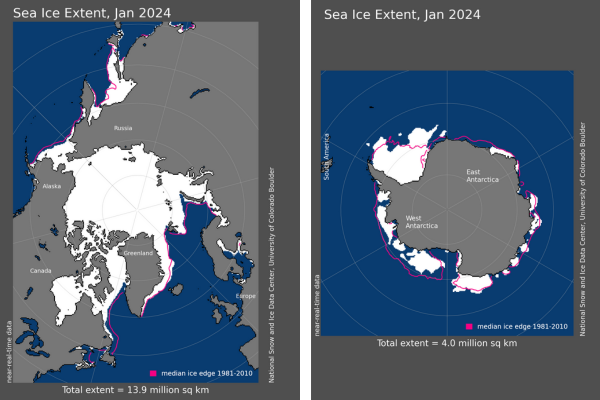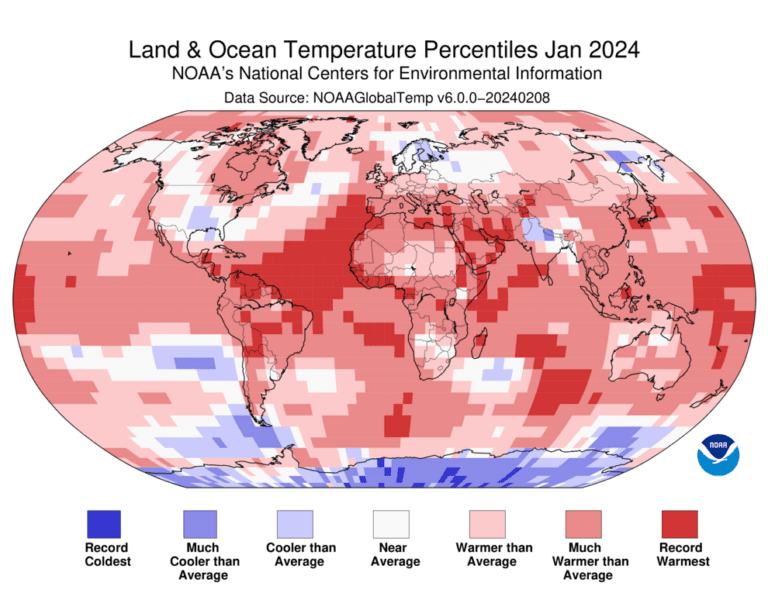Best moments:
- Temperatures were above average across much of the globe, but the eastern United States, most of Europe and some other areas were cooler than average.
- There is a 22% chance that 2024 will be the warmest year in NOAA's 175-year record and a 79% chance that El Niño will transition to neutral conditions by the middle of the year.
- Northern Hemisphere snow cover was near average, but Antarctic sea ice extent was the fifth lowest on record for January.
- Global rainfall was near a record in January, following a record wet December.
Temperature
January's global surface temperature was 2.29°F (1.27°C) above the 20th century average of 54.0°F (12.2°C), making it the warmest January on record. That was 0.07°F (0.04°C) above the previous record from January 2016. According to NCEI's Global Annual Temperature Outlook, there is a 22% chance that 2024 will rank as the warmest year on record and a 99% chance of ranking in the top five.
January marked a record monthly global ocean surface temperature for the 10th consecutive month. The El Niño conditions that emerged in June 2023 continued into January, but according to NOAA Climate Prediction Center it is likely that El Niño will transition to neutral ENSO by April-June 2024 (79% probability), with an increasing chance of La Niña developing in June-August 2024 (55% probability).
Temperatures were above average across the Arctic, most of northeastern North America, central Russia, southern and western Asia, Africa, South America, eastern and southeastern Asia, and Australia. Much of northwestern North America, the central and southern United States, northern and eastern Europe, northeast Asia, and Antarctica experienced below-average temperatures during January. Sea surface temperatures were above average over much of the northern, western and equatorial Pacific Ocean, as well as parts of the western Indian Ocean.
Surface temperatures for January 2024 (°C). The map shows deviations from the 1991–2020 average. Red shows warmer than average and blue shows colder than average.


Snow cover
Northern Hemisphere snow cover extent for January 2024 was close to the 1991–2020 average. Over North America, above-average snowpack extent was observed in parts of the Cascades, central Rockies, central and southern Plains, Midwest, and Appalachians. With above-normal temperatures and an unfavorable storm track for heavy snow, much of the northern Rockies and Upper Midwest experienced a snowfall deficit in January. Over Eurasia, snow cover was below average over most of central and southern Europe, Turkey, central Asia, Nepal and western China. Meanwhile, above-average extent of snow cover was observed in parts of northern Europe, southern Mongolia, northeastern China and Japan.
Sea ice


Global sea ice extent was the seventh smallest in a 46-year record at 6.90 million square miles (440,000 square miles below the 1991-2020 average). Arctic sea ice extent was slightly below average, while Antarctic sea ice extent was well below average (by 420,000 square miles), ranking fifth smallest on record.
Precipitation
Global rainfall was near a record in January, following a record wet December. Large parts of North America, Asia and Australia were wetter than average, while much of southern Africa and South America were drier than normal. The El Niño rainfall pattern in the central and western Pacific Ocean weakened, but patterns in Africa and the southern United States remained more typical of El Niño.
Tropical cyclones
Six named storms occurred across the globe in January, which was about the 1991-2020 average of seven. The only major tropical cyclone was Intense Tropical Cyclone Angrek, which remained in the central part of the South Indian Ocean and did not approach large land masses. Severe tropical storm Alvaro made landfall in Madagascar at the beginning of the month resulting in significant impacts and many casualties. Tropical Cyclone Belal caused widespread flooding in Mauritius and also affected La Reunion. Tropical Cyclone Kirrily brought heavy rain and wind to northeastern Australia.
This monthly summary, developed by scientists at NOAA's National Centers for Environmental Information, is part of a series of climate services that NOAA provides to government, business, academia and the public to support informed decision-making. For a more comprehensive summary of climate conditions and events, see the January 2024 Global Climate Report or explore the Global Climate at a Glance time series.



